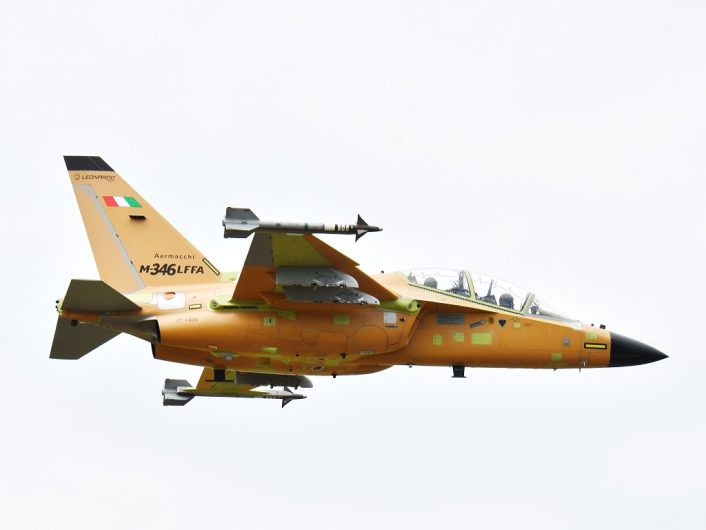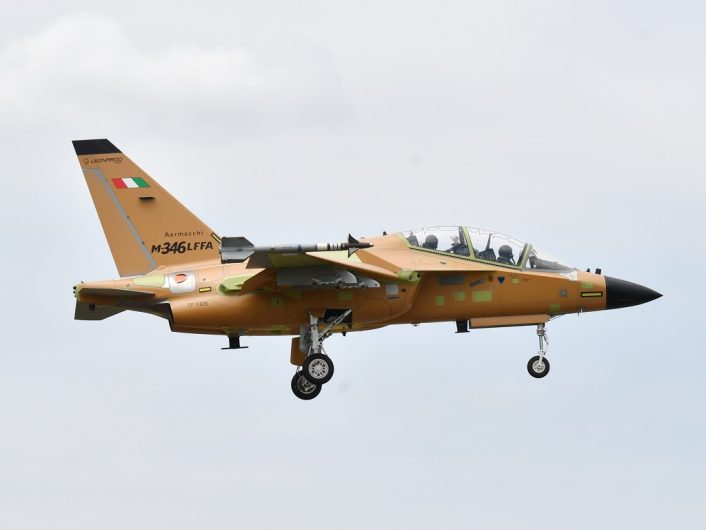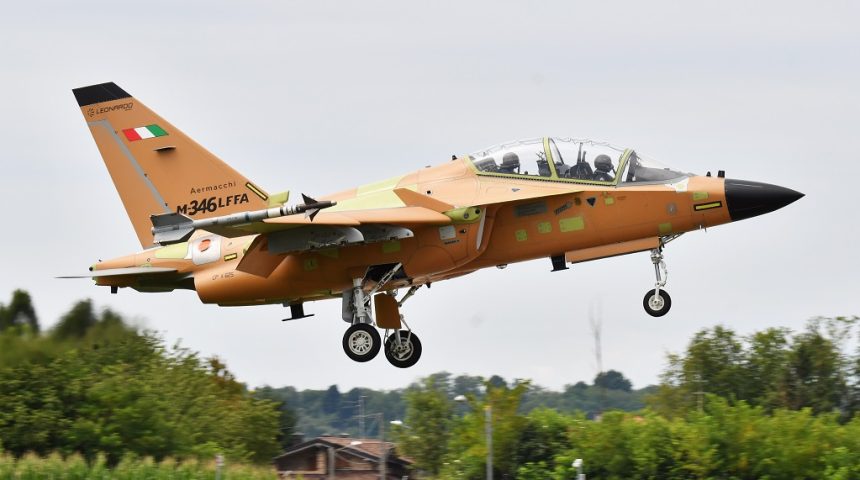The aircraft retains all its training features while being able to perform also a wide range of operational air-to-air and air-to-ground missions.
The new prototype of the Leonardo M-346 Light Fighter Family of Aircraft (LFFA) performed its first flight on July 13, 2020, from Venegono airport, where the company’s final assembly lines are based. The aircraft, formerly known as M-346 Fighter Attack (FA), is the first prototype in complete configuration, featuring all the equipment that differentiates it from the standard M-346 Advanced Jet Trainer (AJT).
The prototype, with serial CPX625, was captured by photographer Oscar Bernardi, who sent us the photos you can see here. The most visible differences from the standard AJT configuration are the two wingtip missile rails, that bring the total hardpoints to seven (two on the wingtips, four under the wings and one under the fuselage), a couple on new antennas on the nose (in front of the cockpit) and under the fuselage (under the both engines), and the Defensive Aid Sub System (DASS).
The DASS features a Radar Warning Receiver (RWR), probably the new SEER digital RWR developed by Leonardo with sensors in the tail and near the wing root’s leading edge (beside the air intakes), a Missile Warning System (MWS), with two sensors along the RWR ones beside the air intakes and two near the wing root’s trailing edge, together with chaff/flare dispensers.
The M-346 LFFA variant is designed to retain the full dual role capability of the AJT version, already in service with the Italian, Israeli, Polish and Singapore Air Forces, while incorporating also some new features like a tactical data link, Grifo-346 mechanical scan, multi-mode radar, new secure radios and IFF system (Identification Friend or Foe), and a stronger airframe.

The aircraft, which is being proposed for Homeland Defence/Air Policing, Slow Mover Intercept, Close Air Support (CAS), Counter INsurgency (COIN), Forward Air Controller – Airborne (FAC-A), Combat Search And Rescue (CSAR), Interdiction, Battlefield Air Interdiction (BAI), Tactical Air Support for Maritime Operations (TASMO) and Tactical Reconnaissance roles, can carry more than 2,000 kg of weapons.
Currently, the M-346 LFFA has been cleared to employ a baseline set of weapons comprising AIM-9 IR-guided air-to-air missiles, Mk-82 free fall bombs, Lizard 2 laser guided bombs and gun pod. The aircraft has been integrated also with the Litening 5 targeting pod and RecceLite recon pod.
Optional weapons include the IRIS-T IR-guided air-to-air missiles, GBU-12 and GBU-16 laser guided bombs, GBU-49 and Lizard 4 laser/GPS guided bombs, GBU-38 and GBU-32 JDAMs, GBU-39 Small Diameter Bombs, Brimstone Air-to-Surface Missiles, Marte ER anti-ship missile, ECM pod and an unspecified medium range air-to-air missile.
The M-346 LFFA maintains the air-to-air refueling capability of the M-346 AJT, being able to perform about two and half hours missions at about 500 nm from the homebase, depending on the mission type and the presence of external fuel tanks.
Many of the M-346 LFFA features were already planned during the development of the first M-346 prototype, after the joint YAK/AEM-130 Technology Demonstrator Program in collaboration with Yakolev. At that time, the aircraft already included future provisions for Helmet Mounted Displays, DASS, targeting and recon pods, nine weapon stations to carry up to 3,000 kg of payload, removable air-to-air refueling probe and both air-to-air and air-to-ground mission capability.
The new aircraft has been already ordered by an unspecified country, while Azerbaijan reportedly signed a memorandum of understanding that could include both the LFFA and AJT variants.

Regarding the performances, the M-346 LFFA page on Leonardo’s website quotes Giacomo Iannelli, Project Test Pilot Trainer of Leonardo’s Aircraft Division, as he gives his impressions of the aircraft during the development in 2018 (before the aircraft was renamed from FA to LFFA):
“First of all, the low altitude speed is very high even with external loads, while other supersonic aircraft have a better performance in a clean configuration, but get considerably worse when loads are added.
The manoeuvrability is excellent thanks also to the 4-channel digital fly-by-wire flight control system and this allows fast manoeuvring during close air combat. The remarkable specific excess power allows the return to base even with full payload, with one engine inoperative (OEI), at an adequate altitude to keep out of the more common range missile threat, guaranteeing a notable survivability capability. The so-called Carefree Handling makes sure that the pilots can focus on the mission, without having to worry about risking to exit the expected flight envelope.
The twin-engine configuration assures a high battlefield survivability and, at the same time, the fuel consumption is kept low thanks to the engine’s efficiency, definitely providing a good range, that can be further extended by air refuelling, a capability which is already operational within Italian Air Force. The Auxiliary Power Unit (APU) assures completely autonomous flight operations.
Furthermore, the visibility is excellent as the M-346 was born as a trainer, it is a two-seater aircraft and this is very important during low altitude flight. The back-seater pilot can also be act as a Weapons System Operator or a more specialised FAC-A (Forward Air Controller – Airborne) role”.
The Aviationist Editor David Cenciotti would like to thank Oscar Bernardi for sending us the photos you can find in this article.









